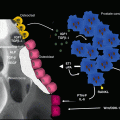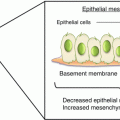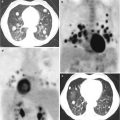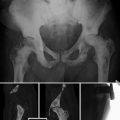© Springer International Publishing Switzerland 2017
Francesco Bertoldo, Francesco Boccardo, Emilio Bombardieri, Laura Evangelista and Riccardo Valdagni (eds.)Bone Metastases from Prostate Cancer 10.1007/978-3-319-42327-2_1111. Chemotherapy
(1)
Department of Medical Oncology, Cliniche Humanitas Gavazzeni, Bergamo, Italy
11.1 Introduction
Nearly all patients with metastatic prostate cancer (PC) become resistant to the initial approach with androgen deprivation therapy (ADT), developing the state known as metastatic castration-resistant prostate cancer (mCRPC) [1]. Up to 30 % of patients can respond to additional hormonal manipulations but responses are usually short lasting [2]. In this setting, chemotherapy has represented for a long time the only available treatment, although its role in providing palliation was in the past controversial [3]. In an early trial published in 1996, treatment with mitoxantrone and prednisone provided palliation in a significantly higher percentage of patients with symptomatic mCRPC, as compared with prednisone alone [4]. Most responding patients had an improvement in quality-of-life (QoL) scales and a decrease in serum prostate-specific antigen (PSA) level; however, no difference in overall survival (OS) between the two treatment arms was found. In 2004, two landmark phase III trials reported a survival advantage and an improvement in QoL over mitoxantrone with the use of docetaxel chemotherapy in men with mCRPC [5, 6]. For nearly a decade, chemotherapy with docetaxel has been the only established standard of care for men with mCRPC. In recent years, treatment of mCRPC has changed dramatically due to the improvement in the understanding of CRPC biology, which has revealed that during the progression to the castrate status, PC cells remain dependent on androgens and on the androgen receptor (AR) signaling pathway [7]. Multiple novel agents that have demonstrated to improve OS, symptom control, and QoL in mCRPC have been approved, including sipuleucel-T, cabazitaxel, abiraterone acetate, enzalutamide, and radium-223 [8–12]. Since docetaxel became the first approved therapy in mCRPC, two registration-driven therapeutic spaces have evolved in this scenario, defined as pre-docetaxel (or chemotherapy-naïve) and post-docetaxel settings [13]. However, this division does not take into account the disease biology. As for many other cancers, it has become clear that PC is a highly heterogeneous disease, characterized by the presence of AR-dependent and AR-independent cellular clones in the same patient [14].
Although several treatments are available for mCRPC, the development of resistance and some degree of cross-resistance between abiraterone and enzalutamide limits the efficacy of these drugs; there is therefore still a high medical need for new treatment options. CRPC molecular profiling studies have shown that up to 30 % of patients harbor DNA repair defects [15]. Some of these alterations have been associated with the antitumor activity of the poly-ADP-ribose polymerase (PARP) inhibitor olaparib in patients with mCRPC [16]. Interestingly, the same biomarkers have been correlated with sensitivity to platinum agents in preclinical studies, renewing the interest in the use of these compounds in molecularly selected patients [17].
Therefore, chemotherapy with docetaxel, cabazitaxel, and possibly platinum agents in selected patients remains an important therapeutic option for patients with mCRPC [18, 19]. In particular, the therapeutic effect of chemotherapy (mainly with docetaxel and cabazitaxel) on bone metastases, which are very frequent in this setting, is well known. It has been reported in terms of pain control or incidence of skeletal-related events (SREs), usually defined as a composite end point, including pathological bone fractures, spinal cord compression, and the need for radiation therapy on symptomatic areas [20].
11.2 Early Experience with Chemotherapy in Metastatic CRPC
Palliative chemotherapy has represented for a long time the only available treatment in mCRPC, although its role in this patient setting was in the past controversial, due to the lack of OS gain with any agent. Methodological limitations, mainly in study design and response assessment, hampered the comparison of different trials [3, 21]. Most agents were tested in the phase II setting. Moreover, PC metastasizes primarily to the bone, and changes in bony disease were often not measurable radiographically. PSA was not evaluated in these early studies. Cyclophosphamide, 5-fluorouracil, streptozotocin, and estramustine phosphate, either alone or in combination, were the most widely used agents [22]. In particular, oral cyclophosphamide was extensively studied in several single-agent and combination studies, with some evidence of both PSA and objective response [23]. Estramustine phosphate is a nitrogen mustard–estradiol conjugate that has both hormonal and nonhormonal effects [24]. Upon uptake into cells, the two parts of the compound split. Its metabolic products include estrone and estradiol, which exert antigonadotropic properties leading to decrease in serum testosterone. The cytotoxic metabolite causes microtubule depolymerization through a direct tubulin interaction. Single-agent estramustine demonstrated only modest activity. Based on a strong in vitro synergy with several other chemotherapeutic agents, a number of combination trials were conducted [25]. The most successful was the phase III Southwest Oncology Group (SWOG) 9916 study that demonstrated a survival advantage with the combination of estramustine and docetaxel compared to mitoxantrone [6].
11.2.1 Mitoxantrone
Mitoxantrone is a synthetic anthracenedione originally developed to improve the therapeutic profile of the anthracyclines. Early single-arm studies suggested some palliative benefit with its association with steroids for patients with metastatic PC progressing on androgen deprivation therapy [26, 27]. Mitoxantrone was subsequently investigated in patients with symptomatic mCRPC using end points of palliation in a Canadian randomized phase III trial [4]. Overall, 161 men with mCRPC and bone pain were randomized to receive mitoxantrone plus prednisone versus prednisone alone. Nonresponding patients on prednisone could cross to mitoxantrone/prednisone. The primary end point was a palliative response, defined as a 2-point decrease in pain assessed using a 6-point pain scale (or complete loss of pain if initially 1+). Palliative response was observed in 23 of 80 patients (29 %) who received mitoxantrone plus prednisone and in 10 of 81 patients (12 %) who received prednisone alone (p = .01). However, no significant difference in PSA response rates and in OS was observed between the two treatment groups. QoL analysis showed a significant improvement in the mitoxantrone-treated patient group (p = .009) [28]. The Canadian mitoxantrone trial was not powered to detect a difference in OS between patients receiving mitoxantrone versus those that did not. A larger trial was therefore conducted by the Cancer and Leukemia Group B (CALGB) [29]. Two hundred forty-two patients with mCRPC were randomized to receive either mitoxantrone and hydrocortisone or hydrocortisone alone. Patients were monitored for OS, time to disease progression (TTP), time to treatment failure (TTF), response, and QoL parameters. Although PSA responses were more common with mitoxantrone (38 % vs 22 %, p = 0.008), and there was a significant delay in TTF and TTP in favor of mitoxantrone arm, there was no difference in OS (12.3 versus 12.6 months for mitoxantrone and hydrocortisone alone arms, respectively). QoL was not improved globally, with an improvement just for a few pain items in mitoxantrone arm.
Due to the effectiveness of taxanes, after the approval of docetaxel and cabazitaxel, mitoxantrone has been no longer used very commonly. In the post-docetaxel setting, it was inferior to cabazitaxel in the TROPIC trial [9]. Also in this setting, mitoxantrone offered no demonstrated survival benefit. In a retrospective analysis comparing control arm data from two large randomized clinical studies (the TROPIC [9] and the SUN 1120 [30] trials), no significant OS benefit was observed for mitoxantrone plus prednisone versus prednisone alone among patients with mCRPC pretreated with docetaxel therapy [31]. Of note, pain response rate of mitoxantrone in a more heavily pretreated population such as that enrolled in TROPIC trial was 7.7 % only [9], far less than the 29 % of palliation reported in the original first-line trial [4]. However, mitoxantrone remains a possible option in docetaxel-pretreated patients with symptomatic skeletal metastases who may not tolerate cabazitaxel due to poor bone marrow function or poor performance status [22].
11.3 Taxanes
11.3.1 General Mechanism of Action
Microtubules are dynamic proteins composed of polymerized tubulin, which is a heterodimer of alpha- and beta-tubulin subunits. They are involved in different cellular functions including mitosis, cellular architecture and transport, cell signaling, and gene expression [32]. The main mechanism of action of taxanes is a dysfunction of the mitotic spindle, which causes a mitotic block and eventually activates the apoptotic cascade [33]. Interestingly, microtubules are implicated in AR signaling, particularly in AR nuclear localization and AR-mediated transcription [34, 35]. In a small study evaluating the effect of taxanes on AR localization in circulating tumor cells of PC patients, 12/17 patients (70.6 %) with response or stable disease had cytoplasmic AR localization, while 13/18 (72 %) of progressors had nuclear AR localization [36]. This complex mechanism of action could at least partially explain why taxanes, which function as microtubule inhibitors, are the most effective chemotherapeutic agents in PC.
11.3.2 Docetaxel
Docetaxel is a semisynthetic taxane that in several early phase II trials had proved active with either a weekly or every-3-week schedule at a dose of 30 and 75 mg/m2, respectively [37–39]. Based on these encouraging data, docetaxel was moved to phase III testing and was approved in the mCRPC setting on the basis of two landmark phase III trials: the TAX 327 study and the SWOG 9916 study [5, 6].
In the TAX 327 trial, 1006 men with mCRPC received 10 mg of prednisone daily and were randomly assigned to receive 12 mg/m2 of mitoxantrone every 3 weeks, 75 mg/m2 of docetaxel every 3 weeks, or 30 mg/m2 of docetaxel weekly for five of every 6 weeks. The primary end point was OS. Secondary end points were pain, PSA levels, and QoL. The median OS for patients treated with docetaxel every 3 weeks was 18.9 months, compared to 16.5 months for patients in the control mitoxantrone arm (HR 0.76, 95% CI 0.62–0.94, p = 0.009). Patients given weekly docetaxel had a median OS of 17.4 months (HR 0.91, 95% CI 0.75–1.11; p = 0.36). PSA decrease of at least 50 % occurred in 32 %, 45 %, and 48 % of men in the mitoxantrone, every-3-week docetaxel, and weekly docetaxel, respectively (p < 0.001 for both comparisons with mitoxantrone). Among these three groups, 22 %, 35 %(p = 0.01), and 31 % (p = 0.08) of patients had predefined reductions in pain, and 13 %, 22 % (p = 0.009), and 23 % (p = 0.005) had improvements in the QoL. Adverse events were more common in the groups that received docetaxel. However, most adverse events associated with docetaxel were of low grades. An updated survival analysis confirmed the OS benefit with docetaxel given every 3 weeks [40]. More patients survived 3 years when treated with docetaxel either every 3 weeks or weekly (18.6 % and 16.6 %, respectively, as compared to 13.5 % with mitoxantrone); however, the survival benefit with weekly docetaxel was not statistically significant; moreover, men treated with weekly docetaxel were more likely to experience early deterioration of QoL. Therefore, there is general consensus that weekly docetaxel schedule should not be adopted, with the possible exception of patients with poor performance status who are at high risk of hematological toxicity (mainly febrile neutropenia). The TAX 327 trial included patients with and without symptoms. The OS benefit was consistent through all the patient subgroups. In general, the chances of prolonging survival with docetaxel seemed similar among patients with higher and lower disease burden, as indicated by level of serum PSA, the presence or absence of pain, and the QoL or performance score [40]. Visceral disease, pain, poorer performance status, and higher values of baseline PSA were negative prognostic factors across all the study arms.
The SWOG 9916 was a phase III randomized study, in which 770 patients with mCRPC were randomized to receive 280 mg of estramustine three times daily on days 1 through 5, 60 mg/m2 of docetaxel on day 2, and 60 mg of dexamethasone in three divided doses before docetaxel or 12 mg/m2 of mitoxantrone on day 1 plus 5 mg of prednisone twice daily [6]. Both treatments were given in 21-day cycles. The primary end point was OS; secondary end points were PFS, objective response rate, and PSA response. In an intention-to-treat analysis, the median OS was longer in the group given docetaxel and estramustine (17.5 months vs 15.6 months, HR 0.80, 95% CI 0.67–0.97, p = 0.02). PFS (6.3 versus 3.2 months, p < 0.001) and PSA response rate were significantly superior in the docetaxel arm, while no significant difference was observed in objective response rate between the two arms. Pain relief was similar in both groups. Grade 3–4 febrile neutropenia, nausea and vomiting, and cardiovascular events were more common in the docetaxel arm. HR and median OS in the docetaxel arm were similar to those reported in the TAX 327 study; however, the SWOG 9916 trial failed to meet its primary aim of detecting a 33 % improvement in median OS with estramustine and docetaxel. Of note, the median OS of 15.6 months among men treated with mitoxantrone and prednisone was longer than that reported in the original Canadian trial [4], probably due to different eligibility criteria, in particular as regards the inclusion of symptomatic patients only in that study.
It is difficult to compare these two landmark trials. However, the addition of estramustine seems to add no benefit, while increasing toxicity. A randomized phase II trial conducted on 150 patients evaluating docetaxel/prednisone either with or without estramustine found no statistically significant difference in PSA response rates between the two arms, while grade 3–4 toxicities were increased with the addition of estramustine to docetaxel (45 % versus 21 %, p = 0.005). Of special concern is the reported association of estramustine with venous thromboembolic events [41].
11.3.3 Docetaxel-Based Combinations
A number of novel agents have been investigated in combination with docetaxel/prednisone, in the attempt to improve response rates and survival outcomes. However, no combination proved superior to the reference regimen. Despite a preclinical rationale, the combinations of docetaxel with anti-angiogenic agents, including bevacizumab [42] and aflibercept [43], have been consistently disappointing. Similarly, no efficacy improvement was found with the addition of bone-targeting agents such as atrasentan [44], dasatinib [45], and ZD4054 [46]. Another phase III trial evaluated docetaxel with or without custirsen (previously called OGX-011), an antisense oligonucleotide inhibitor of the production of clusterin. Clusterin is a chaperone protein associated with treatment resistance and upregulated by apoptotic stressors such as chemotherapy. The SYNERGY trial evaluated docetaxel ± custirsen as first-line therapy in men with mCRPC (N = 1022). Median OS was 23.4 months vs. 22.2 m for custirsen and control arms, respectively (HR 0.93; p = 0.42). When the study population was retrospectively split in two prognostic categories according to a trial-specific nomogram, patient with poor prognosis appeared to benefit from the addition of custirsen [47].
Reasons for the failure of these combination regimens are probably the marginal activity of the added compound on mCRPC and also the dose reduction of docetaxel due to the overlapping toxicities.
11.3.4 Docetaxel Rechallenge
Several treatment options are currently available for men with mCRPC, including second-line chemotherapy with cabazitaxel, hormonal therapy with abiraterone and enzalutamide, and radiopharmaceuticals such as radium-223. A great benefit is expected by their combined and sequential use [48]. However, until a few years ago, chemotherapy with docetaxel was the only established standard of care in this setting. Selected patients with a prior response to docetaxel could therefore be candidate for re-treatment with the same drug, although the risk of cumulative toxicity could potentially outweigh the treatment benefit. This strategy has been never assessed in a randomized trial [49]. However, some retrospective studies and a few small prospective series have explored this therapeutic modality. Di Lorenzo et al. [50] reported a PSA response in 25 % of patients, with a medium PFS of 5 months and a median OS of 13 months. Peripheral neurotoxicity was the most relevant adverse event. Oudard et al. evaluated in a retrospective study 270 mCRPC patients with prior response to docetaxel; 223 of them were rechallenged with docetaxel. The treatment was associated with PSA response and symptom relief; however, no improvement in OS was reported in comparison to 47 patients not receiving docetaxel rechallenge [51]. Finally, Caffo et al. assessed in 46 patients factors predicting the efficacy of docetaxel rechallenge [52]. Response to previous treatment with docetaxel and time from previous chemotherapy were predictive of response to rechallenge in multivariate analysis. Sensory neuropathy and nail toxicity were the main cumulative adverse events.
In the modern multidrug scenario, data about the use of docetaxel rechallenge in patients pretreated with novel hormonotherapy and/or cabazitaxel are so far lacking. However, due to the increasing use of early docetaxel in castration-sensitive PC, the number of patients re-treated with docetaxel is probably going to increase steadily. Emerging data on the presence of splice variants of AR (namely, AR-V7) in circulating tumor cells as a potential predictive factor of resistance to abiraterone and enzalutamide [53], and of response to chemotherapy [54, 55], will hopefully contribute to identify the optimal candidates to this therapeutic option.
11.3.5 Cabazitaxel
Cabazitaxel is a novel taxane that showed activity against docetaxel-resistant PC in cell lines in vitro and in vivo animal models [33, 56]. Like other taxanes, cabazitaxel exerts its antitumor cytotoxic activity through the mitotic arrest at the metaphase to anaphase transition, leading to cell death by apoptosis. Cabazitaxel demonstrated a lower binding affinity as compared to docetaxel for multidrug resistance (MDR) proteins, considered a major mechanism of resistance [57]. Another attractive property of cabazitaxel is its enhanced solubility in water-based solutions compared with other taxanes, enabling better blood–brain barrier penetration and higher central nervous system concentrations with systemic administration in mouse models [58]. Two phase I studies evaluated the safety and pharmacokinetic properties of cabazitaxel across various solid tumor types [59, 60]. In the first study [59], cabazitaxel was generally well tolerated up to 25 mg/m2, grade 4 neutropenia was commonly observed at this dose, and the investigators concluded that a dose of 20 mg/m2 every 3 weeks was appropriate for further clinical testing. Of three patients who achieved partial responses to treatment, two had mCRPC, including one who had previously been treated with docetaxel. Another phase I study concluded that the hematologic dose-limiting toxicity was seen at 30 mg/m2 [60]. Two separate phase II studies were conducted in women with metastatic breast cancer, showing efficacy and safety of cabazitaxel despite prior progression on taxane therapy [61, 62]. Based on these results, and without first conducting phase II studies in PC, cabazitaxel was evaluated in a phase III study (the TROPIC trial) in men with docetaxel-resistant mCRPC [9]. To ensure docetaxel resistance, a cumulative dose of docetaxel greater than 225 mg/m2 was required. The TROPIC trial evaluated cabazitaxel in association with prednisone compared with mitoxantrone and prednisone in 775 mCRPC patients with disease progression during (29 %) or after (71 %) docetaxel-based chemotherapy. The primary end point was OS. Secondary end points included PFS, safety, and pain control. At the cutoff for the final analysis, median OS was 15.1 months in the cabazitaxel group and 12.7 months in the mitoxantrone group, with an HR of 0.70 (95 % CI 0.59–0.83, p < 0.0001). Median PFS was 2.8 months in the cabazitaxel group and 1.4 months in the mitoxantrone group (HR 0.74, 0.64–0.86, p < 0.0001). PSA and tumor response rates, as well as pain control, were also significantly higher in the cabazitaxel group. An updated analysis of the TROPIC trial with longer follow-up confirmed a sustained OS benefit for treatment with cabazitaxel, which was predictive of survival over 2 years [63]. The most common grade 3 or higher adverse event with cabazitaxel was neutropenia, observed in 82 % of cabazitaxel patients versus 58 % of mitoxantrone; febrile neutropenia was registered in 8 % of patients in the cabazitaxel group and in 1 % in the mitoxantrone group. Grade 3–4 anemia (11 %) and thrombocytopenia (4 %) were far less common. Frequent nonhematologic toxicities were gastrointestinal disturbances such as diarrhea, nausea/vomiting, and constipation. Importantly in a population of patients pretreated with docetaxel, a severe peripheral neuropathy was observed in less than 1 % of cases. Fatal adverse reactions with cabazitaxel were reported in five patients due to infections and in four due to renal failure [9, 63].
The high degree of neutropenia reported in the TROPIC trial has raised some concern about the use of the drug, particularly in unfit and elderly patients. Several retrospective reports of patient series treated in a “real-world” setting have therefore analyzed the issue of cabazitaxel toxicity [64–68]. The results of these studies suggest that cabazitaxel has a manageable safety profile in everyday clinical practice. In the largest series, including 746 men with mCRPC, multivariate analysis showed that age ≥75 years, treatment cycle 1, and neutrophil count <4000/mm3 before cabazitaxel administration were associated with increased risk of developing grade ≥3 neutropenia and/or neutropenic complications. Prophylactic use of G-CSF significantly reduced this risk by 30 % [64]. Another study investigated in 112 patients with mCRPC, from 12 UK institutions, the impact of cabazitaxel on QoL [68]. This study provided the evidence, even though by a non-randomized analysis, that cabazitaxel improved QoL, particularly with regard to pain scores.
Stay updated, free articles. Join our Telegram channel

Full access? Get Clinical Tree








